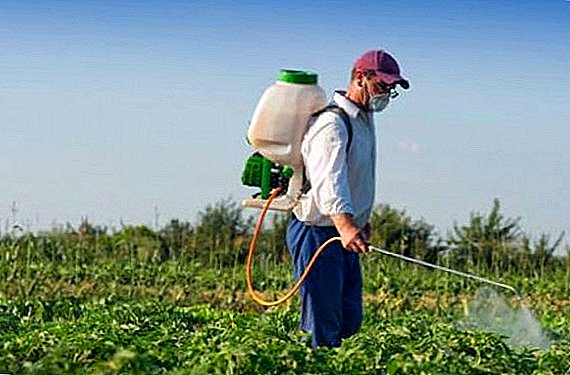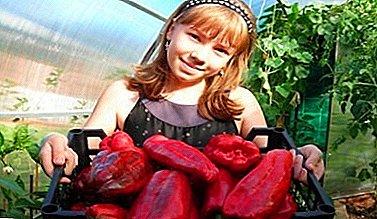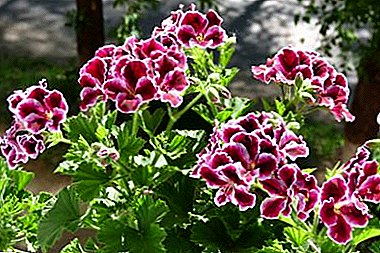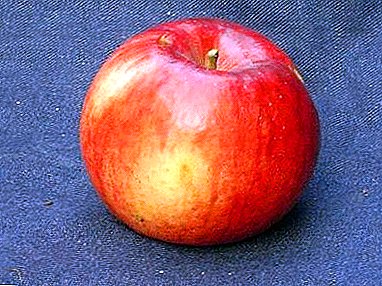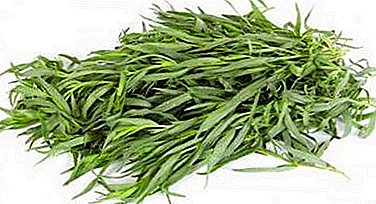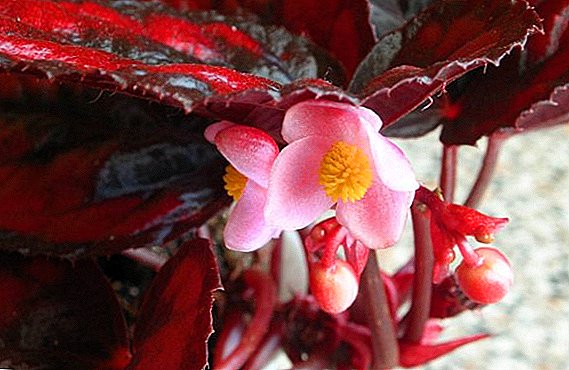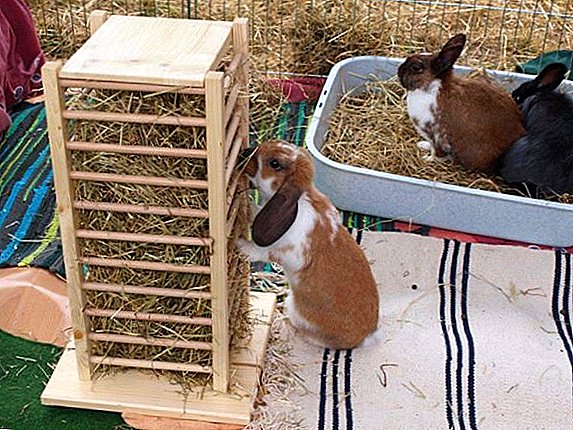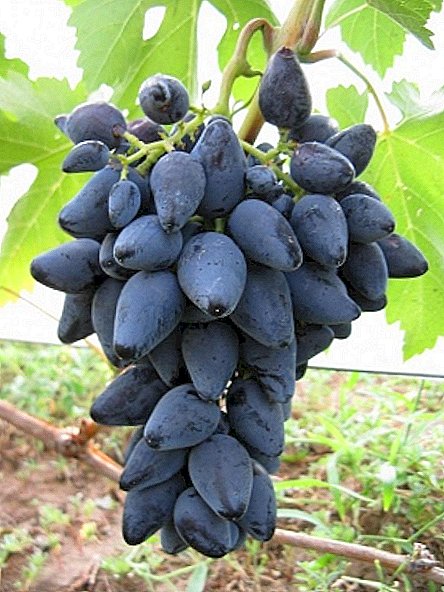
Today, the area of grape cultivation has ceased to be limited to the southern territories.
Thanks to the new ways of breeding and protection, sprouting and fruiting vines began to appear in almost every garden.
There are many different grape varieties, which differ in appearance and taste.
One of the new types is Viking, a table grape variety. About him and will be discussed.
Description of the grape variety "Viking"

The Viking grape variety is the fruit of the work of the breeder VS Zagorulko. and obtained by crossing varieties AIA-1 and Kodryanka.
The grape "Viking" is early varietywhich ripens in 110 - 120 days. It is also established that the "Viking" begins to bear fruit for 3 - 4 days earlier than the "Codrean".
In addition, the grape variety in question is able to remain on the vine for a long time. Bushes grow well, vines are vigorous. Sheets are medium or large in size, flowers are bisexual, bloom in early June.
A cluster of medium size, with an average density, has a conical or cylindrical shape, the mass ranges from 500 to 750 g, sometimes up to 1 kg. The berries are dark blue, have an oblong ovoid shape, large (32 x 23 mm), reach 8 - 12 g in weight. The flesh is juicy, sweet-sour, in the taste there are notes of prunes and berries. The skin is thin, almost not felt when consumed.
Yield at the "Viking" average. It can withstand a drop in temperature down to -21 ° С. There is also a fairly low resistance to mildew and oidium.
Virtues:
- quite high frost resistance
- tastes great berries
- fast ripening
disadvantages:
- average yield
- strongly affected by mildew, oidium
About the features of planting varieties

This grape variety need fertile soil, as the absence of beneficial trace elements in the ground will lead to a deterioration in the taste of the grapes. Therefore, it is better to grow Viking in fertile soils, for example, black soil.
Between the two bushes should be enough space, so the distance between the seedlings should be about 2.5 - 3 m.
You can plant seedlings either in spring or in autumn. The main thing is that the temperature is within 15 - 25 ° C, since the growth rate of future grapes depends on the temperature.
Before landing you need check every seedling. Ideally, it should have at least four roots with a thickness of 1.5 - 2 mm, and the length should reach 10 cm.
In addition, the seedling must be elastic, not break when bent, healthy looking (there are no mechanical damage and signs of exposure to fungal diseases).
The ripened growth must be at least 20 cm with 4 to 5 buds.
It is important that the roots of the seedlings are not dried, as it will be impossible to restore them. Before planting, the roots are immersed in water with the addition of growth stimulants (gibberellin, heteroauxin).
For proper planting, you need to dig a hole (0.8x0.8x0.8 m), at the bottom of which nutritious mound from a mixture of humus (7 - 10 buckets) and fertile soil.
The height of this layer must be at least 25 cm. After the whole mixture is filled and compacted at the bottom of the pit, mineral fertilizers (300 g of superphosphate and potash fertilizers) must be applied to a depth of 5 cm and rammed the ground again.
Next, from the fertile soil you need to make a mound no more than 5 cm high, on which you should then put a seedling and straighten the roots.
Such a seedling should be covered with fertile soil before growth (the height of such an embankment should be approximately 25 cm). At the end of the seedling watered with 2 - 3 buckets of water. After the moisture is absorbed, the earth needs to be loosened. After planting, it is necessary to produce another 2 irrigations at intervals of 2 weeks, loosen the soil and cover it with mulch.
Viking Care Tips
- Watering

"Viking" does not like an oversupply of water, so you need to be careful with watering.
It is necessary to water grapes in the period from mid-April to mid-October.
The first time watering is done at the beginning of the season, immediately after the dry garter of the shoots was made.
The second time you can pour the vine after pruning, but in the absence of paska (sap - this selection of juice in the cut, like a vine "crying"). If the sap appears in small quantities, then water the grapes is undesirable.
For the third time, watering should be done when the shoots reach a length of 25-30 cm.
When the time of flowering vines, it is time to water the grapes for the fourth time. Grapes can not be watered at the beginning or during flowering, as such watering will cause the flowers to crumble.
The fifth time the vine needs to be watered when clusters began to form (when the berries resemble small peas in size). This watering will lead to improved yield.
The sixth watering helps to soften the berries of the bunch.
The last time the grapes are watered after the crop was harvested. Be sure to follow the weather, in case of drought grapes may need moisture.
- Mulching
Mulching is a necessary procedure that protects the roots of grapes from hypothermia and dehydration, increases the access of oxygen to the root system, and also prevents the development of weeds.
It is necessary to carry out the laying of mulch throughout the year. Suitable materials will be sawdust, straw, mulch paper, peat. This protective the layer should reach 5 - 10 cm.
- Harboring
You need to cover courses in mid-October or a bit later, it all depends on the weather. As materials for this procedure, you can use the ground, polymer films or improvised means.
If you protect the vines with earth, then before that you must plentifully water all the bushes so that the water goes deep enough.
The vines of each bush need to be tied and laid on the pre-bedded material (slate strips, polyethylene) in order to avoid rotting. Next, the vines are covered with a layer of 15 to 20 cm. At the end, another watering is needed.
Another way to shelter grapes is polyethylene cover. To do this, the vine must be fixed on the ground, and above the branches it is necessary to install metal arcs on which polyethylene is stretched. The film is fixed on the sides of the ground or other devices.
Since the "Viking" is a fairly frost-resistant variety, the second layer of polyethylene is not needed for the vines of this grape.
It is very important that the shoots do not touch the coating, otherwise frost bells will be formed.
The ends of the film must be left open for access of air, but they will still have to be closed when the temperature drops below 8-10 ° C.
It is also interesting to read about the best varieties of pink grapes.
- Pruning
Cut the vines to fall, which will give the opportunity to better cover it.
When pruning a young seedling in the first year, it is necessary to cut off the matured vine, and then to shorten the young shoots, leaving at the same time from two to five buds.
Important remove extra shoots, so that 3 - 8 sleeves remain (fruitful shoots that grow at an angle out of the ground).
When pruning "adult" Viking bushes, you need to leave long shoots, otherwise the bush will be large and the fruits will be small. Such pruning is done at the beginning of the growing season. It is necessary to cut 12 to 20 buds, depending on the length of the vine and the age of the bush.
- Fertilizer
Variety "Viking", like any other grapes, needs regular feeding for better fruiting.
It is necessary to fertilize bushes 2 - 3 times during the growing season with an interval of 3 - 4 weeks. It is better to combine top dressing with irrigation for better passage of fertilizers to the ground.
The first time you need to make a small amount of nitrogen and organic fertilizers (1.5 - 2 tablespoons of ammonium nitrate per 10 liters of manure solution). This feeding is done at the beginning of the season.
During the fourth irrigation, fertilizing with zinc salts, potassium sulfate or superphosphate is necessary for better pollination. The following fertilization procedure should coincide with the sixth irrigation and include the introduction of superphosphate and potassium sulfate.
Organics should be applied once every 2 - 3 years, 15 kg per bush, falling asleep fertilizer into pits 50 cm deep dug along the periphery of the bush.
- Protection

Viking can be badly damaged by mildew and oidium, so you need to protect the bushes from the effects of these fungal diseases.
Evidence that grapes are damaged by mildew is yellow oily spots on leaves.
The causative agent of this disease is fungus. For treatment and prophylaxis, it is necessary to process the grapes 3 times: the first - when the young shoots have grown to 15 - 20 cm, the second - before flowering, the third - after flowering.
The treatment is carried out with fungicides such as anthracol, strobe or Ridomil gold. Signs of oidium is the appearance of gray dust on the leaves. Methods of struggle are the same as in the treatment of mildew


